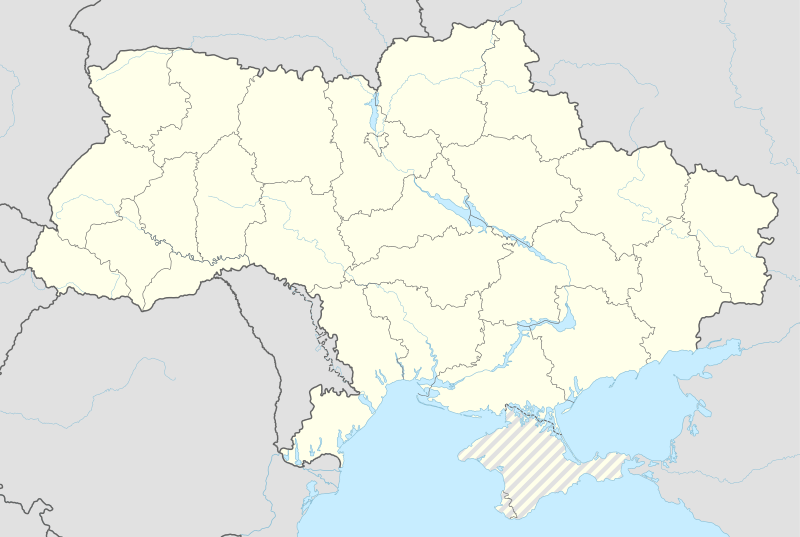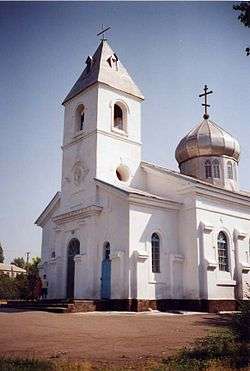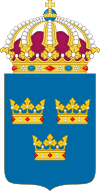Gammalsvenskby


Verbivka (Standard Swedish: Gammalsvenskby, local Swedish dialect: Gammölsvänskbi; literally: "Old Swedish Village"; Ukrainian Старошведське, Staroshvedske; German Alt-Schwedendorf) is a former village that is now a neighborhood of another village of Zmiivka (Ukrainian: Зміївка) in Beryslav Raion of Kherson Oblast, Ukraine. It is famous for having close relations to the Swedish cultural heritage.
The village of Zmiyivka itself also includes three former villages settled by ethnic Germans. These were the two Lutheran villages of Schlangendorf and Mühlhausendorf and the Roman Catholic village of Klosterdorf. In the nineteenth century, the whole region, and large parts of southern Russia contained villages settled by Germans belonging to various Protestant faiths, particularly Lutherans and Mennonites, as well as Roman Catholics. Askania-Nova biosphere reserve is nearby.
Resettlement of Baltic Swedes and founding of Altschwedendorf

The population of Gammalsvenskby traces its origins to Hiiumaa (Dagö) in present-day Estonia, once a part of the Duchy of Estonia.[1] According to the Treaty of Nystad, the island was ceded to the Russian Empire. The part of the local peasant population who were in conflict with the local aristocracy petitioned the Russian Empress to accept them as their subjects.[1] Catherine II of Russia accepted the petition under the condition that the peasants were to be resettled in the newly conquered territories from the Ottoman Empire that were named New Russia (today in the Southern Ukraine).[1] Enticed by promises of new fertile land, they trekked overland to southern Ukraine, as colonists for the new territories that Russia had won from the Ottoman Empire. While some sources call the Estonian Swedes' migration an outright expulsion from their Baltic homeland, other accounts stress the fact that these poor and oppressed serf farmers were given what may have seemed like a generous offer to them. Regardless of the impetus, the outcome of this mass migration was, however, disastrous.[1] Less than half of the nearly 1,000 villagers died on the march to their new home[1] to which they were required to get to on their own.[1] On arrival, they found no trace of the houses they had expected to find. Moreover, in their first year in Ukraine, an even larger portion of the settlers died. According to the records of the Swedish congregation, of the original thousand or so who had set out for Ukraine 18 months earlier, only 135 people remained alive by March 1783, a terrible reduction in their numbers.
Maintaining the Swedish heritage
Three neighbouring villages were founded in the years 1803 to 1805 by German colonists: Schlangendorf, Mühlhausendorf and Klosterdorf. Prince Potiomkin gave a wooden church to the Swedes. It was burned down in the mid-19th century. As a consequence of the later arrival of the Germans and their own losses during the migration, the Swedes were soon outnumbered by the German newcomers. As a result, in later years many of the pastors and teachers serving the area were German. This, along with a growing shortage of arable land caused the relations between the Gammalsvenskby's Swedes and the nearby German population to become rather strained at times.
Although contacts with Sweden were virtually nonexistent for nearly a century, the people of Gammalsvenskby maintained their traditions and their Lutheran (Church of Sweden) faith. They also kept their old Swedish dialect. At the end of the 19th century, some ties were reestablished. Considerable funds were raised in Sweden and Finland to build a new Swedish church. The resulting parish church of St John was opened in 1885. For a time, before the revolutions following World War I, visits from Sweden became rather frequent, and some villagers even subscribed to Swedish newspapers.
Relocation attempt to Sweden

World War I once again cut off the communication channels. After the Russian Civil War, the Government of Sweden worrying about the fate of its compatriots in 1921 petitioned to Moscow to allow residents of Swedendorf to leave for their historical homeland.[1] This movement also was supported by Archbishop Nathan Söderblom. Kremlin decided to negotiate the terms.[1] However, the Ukrainian Swedes who already adopted to the Kherson Region started to grumbled against it as in Ukraine they had own houses with land and farms.[1] From Stockholm to Alt-Swedendorf departed emissaries to convince the compatriots to leave the unstable Ukraine.[1] Negotiations with the Bolshevik regime and the Ukrainian Swedes stretched for almost eight years.[1] In 1929 the Moscow finally allowed for the Alt-Swedendorf residents to leave, but under a condition that they will leave only with what they can take on a passenger train.[1] On August 1, 1929, with a heavy heart Swedes left the Kherson land[1] and around 900 villagers arrived in Sweden. They were received by Prince Carl, Duke of Västergötland in a restaurant.[1] Just a handful had opted to remain in Gammalsvenskby. Nearly a hundred soon moved on to Canada, a country to which earlier emigrants from Gammalsvenskby had gone. Most of them settled in Manitoba. Some later returned to Sweden.
The majority of the villagers stayed in Sweden, many of them settling in Gotland. Despite their common origins, they were not allowed to stay in a single, common settlement. Considered immigrants in a country in the middle of a severe economic crisis, they were sometimes met with hostility. About four months after arriving to Sweden, some emigrants requested to return back to Ukraine.[1] Peter Knutas and Waldemar Utas wrote to the Government of Ukraine that the move was a thoughtless step.[1] On the behalf of three families they were asking the Soviet authorities to allow them return to Ukraine.[1] Some emigrants joined the Communist Party of Sweden in hope to reflect their loyalty to the Soviet authorities.[1]
Soviet repressions and Holodomor
In total, around 250 villagers chose to return to the Soviet Union. Together with members of the Communist Party of Sweden, they established a minor collective farm called Svedkompartiya – the Swedish Communist Party.
In 1929, the church was closed by the Soviet government. Life in the Soviet Union turned out to be hard. The famine of 1932–1933 renewed interest in the idea of returning to Sweden – some villagers signed a list stating that they wanted to leave the country. This led to the arrest of 20 people by the secret police, the GPU. Five of them were sent to prison. Several villagers were killed in the Stalinist purge of the following years. In 1930s the majority of the 3.5 thousands Scandinavian descendants who lived in the Southern Ukraine were accused of spying and sent along with their families to katorga in Siberia and Karelia.[1]
When the German army marched into the village on August 25, 1941, the soldiers were welcomed as liberators. With the retreat of the German army in 1943, the Swedes were evacuated along with the Germans of the area. Many ended up in Krotoschyn in Warthegau in occupied Poland, and nearly 150 were caught by Soviet authorities at the end of the war and sent to labor camps – Gulags, but were allowed to return to Ukraine as early as 1947. Others managed to go to Sweden or directly back to Gammalsvenskby. After World War II, Schlagendorf became Zmiivka (Snake-village), Mühlhausendorf became Mykhailivka (Michael's village), and Klosterdorf became Kostirka. Gammalsvenskby was renamed Verbivka (Willow-village). In 1951, the church (locally - kircha) became first a club, and later an agricultural storehouse. In 1951, after the exchange of territories by Poland and the Soviet Union, around 2,500 people were relocated to the area from the Drohobych Oblast villages of Lodyna, Dolyshni Berehy, and Naniv. Due to the resulting increase in population, the four villages were united into one larger combined village under the name Zmiivka. The village became home to the largest Boykos diaspora in Kherson Oblast (constituting approximately 80% of villagers). The newly relocated populace was officially prohibited from celebrating their traditional holidays such as Vertep during Christmas. To make matters worse, the locals among whom they were settled considered the newcomers to be Nazi-collaborators.
Gammalsvenskby today

After the fall of the Soviet Union, contacts with Sweden and Canada were reestablished. The Church of Sweden and Gotland Municipality have lent economic support. In 1996, Chumak, a Swedish-owned producer of oil, ketchup and canned food, was established in the nearby town of Kakhovka. Today, the village has only around 108 people who share a Swedish cultural heritage. Only a few of them still speak the Old-Swedish dialect fluently and German is often used instead. Zmiivka's emblem consists of three crowns, the Swedish national symbol (Tre Kronor), as well as a blue cross on a yellow field (the Swedish flag has a yellow cross on blue; see also nordic cross flag).
The whole raion of Beryslav is heavily Ukrainianized due to the fact that a lot of people from western Ukraine were resettled here. Local villages include Lvivski Otruby, Lvove, Tarasa Shevchenka, which reflect the resettlement of the west-Ukrainian residents. In 2008, the Swedish King and Queen visited Gammalsvenskby.
| Old-Swedish | Swedish | English |
|---|---|---|
| Pärter | Ankor | Ducks |
| Kardefflar | Potatis | Potatoes |
| Baglescani | Tomater | Tomatoes |
See also
References
External links and further reading
| Wikimedia Commons has media related to Gammalsvenskby. |
- Stockholmnews:Swedish village in Ukraine (October 2009)
- The Svenskbyborna society in Sweden (Swedish)
- A comprehensive history of Gammalsvenskby at the Wayback Machine (archived February 17, 2011)
- A page about Gammalsvenskby (Swedish)
- Recent short article on Gammalsvenskby: A Swedish village in Ukraine, in Hidden Europe magazine, May 2006 (Issue 8), pp. 40–43. ISSN 1860-6318. hidden europe
- Photos from Gammalsvenskby
Coordinates: 46°52′29″N 33°35′16″E / 46.874675°N 33.587664°E



